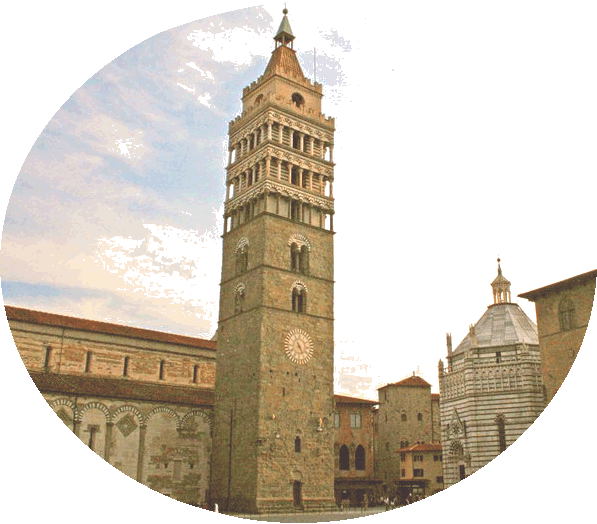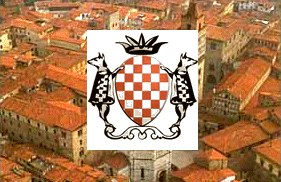|
|
DISCOVERING
PISTOIA
PIAZZA DEL
DUOMO
 This
piazza has always represented the heart of the city. In fact the Romans
first settled here when, to better fight off the Ligurian peoples, they
extended the Cassia road beyond the Fiorentine territory. The Pistoia of
Roman times was confined to the area that would later be enclosed in the
first city wall; today traces can still be seen in the many artifacts
that have been brought to light during archaeological excavations. In
the layout of the Roman city, what today is the piazza was really the
crossroads between the two main streets: the cardo maximus and the
decumanus maximus which traditionally determmned the regularity of the
urban plan. The Cassia road, corresponding to the decumano, came from
the side of the square where the Palazzo degli Anziani, would be built
in later Medieval times and continued along what is now via degli Orafi.
The cardo maximus can be seen today in via Bracciolini. At the
intersection of the two, there was the forum and an aristocratic
residence whose existence is proved by an elegant mosaic floor.
Presumably the piazza had witnessed a more ancient Etruscan settlement,
as is suggested by the two stone funerary markers found nearby and now
displayed in the archaeological section of the Palazzo dei Vescovi.
After the barbarian invasions and the rise to power of the Lombard
governor, the piazza lost its central function in public life and the
focus of activity shifted temporarily to the area around the piazza
della Sala where the governor's house had been built. This
piazza has always represented the heart of the city. In fact the Romans
first settled here when, to better fight off the Ligurian peoples, they
extended the Cassia road beyond the Fiorentine territory. The Pistoia of
Roman times was confined to the area that would later be enclosed in the
first city wall; today traces can still be seen in the many artifacts
that have been brought to light during archaeological excavations. In
the layout of the Roman city, what today is the piazza was really the
crossroads between the two main streets: the cardo maximus and the
decumanus maximus which traditionally determmned the regularity of the
urban plan. The Cassia road, corresponding to the decumano, came from
the side of the square where the Palazzo degli Anziani, would be built
in later Medieval times and continued along what is now via degli Orafi.
The cardo maximus can be seen today in via Bracciolini. At the
intersection of the two, there was the forum and an aristocratic
residence whose existence is proved by an elegant mosaic floor.
Presumably the piazza had witnessed a more ancient Etruscan settlement,
as is suggested by the two stone funerary markers found nearby and now
displayed in the archaeological section of the Palazzo dei Vescovi.
After the barbarian invasions and the rise to power of the Lombard
governor, the piazza lost its central function in public life and the
focus of activity shifted temporarily to the area around the piazza
della Sala where the governor's house had been built.
The cathedral square regained importance in Medieval times: it was the
marketplace, a use it still conserves today, and it became once more the
political and religious center of Pistoia. In that period it developed
the characteristic appearance it has today: a large open space defined
by excellent examples of Romanesque and Gothic architecture that make it
one of the most beautiful squares in Italy. The cathedral of San Zeno
and the Baptistery of San Giovanni in Corte, were
built in the eleventh century; later the Palazzo dei Vescovi and the
first nucleus of Palazzo Pretorio were constructed. Around the end
of the thirteenth century a whole quarter was demolished to make way for
the Palazzo del Comune.
In the 1600s the cathedral's new tribune was built. A hundred years
later the fourteenth-century Loggia degli Anziani (which several prints
of that period show near the bell tower) was torn down; in the same
period Baron Bracciolini built the palazzo that today houses a bank. In
the nineteenth century Palazzo Pretorio, the old prefectural building,
was enlarged; today the prefecture is located in a building constructed
in the first half of this century, replacing an older construction that
the Pistoians used to call the palazzaccio for its unfinished look.
Today the piazza del Duomo continues to concentrate around it, in a
unique way, all the most important buildings of religious, political and
judicial power.

PISTOIA
PHOTOGALLERY
PISTOIA CITY MAP
|